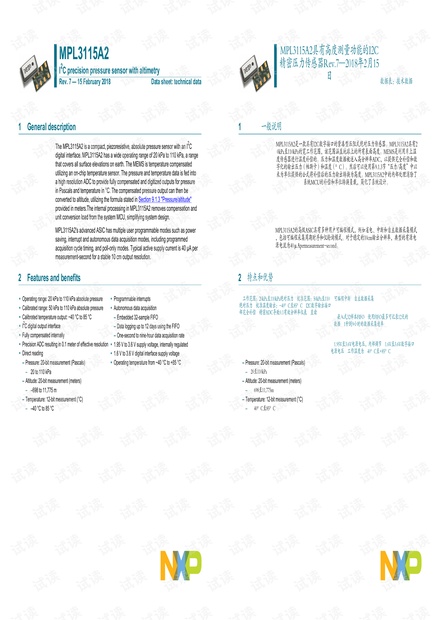
NXP Semiconductors
MPL3115A2
MPL3115A2
4 / 52
8
8.1
ttptf FM fGe
fF pft
AF––3e
FA fGe uefo3
uefo3 2FPeM Fy fGe
Pe38 GoAh3e fGe
5bb38R
o PoMpef8 Fy
b3p2ofpFA• pf
bb3peM fF
ofe o tbe2po3
oMe AFf
Fy fGe hePp2eR
e pAFbeMoL3eR
8.2
ptbeAteh
M botfe
MoAtbFMf fF fGe
eAf pt AFf
Pp2eR
–e oAh y35= f8betR
2fpFA LefIeeA
o8 Le
pAm fGe tF3heM
eAftR
e2FuueAheh
pAm Fy fGe b2L
eAheh fGe
M ueoAt
fGe n7n— hePp2e•
带高度计的I2C精密压力传感器
本文档中提供的所有信息均受法律免责声明的约束。
NXPB.V.2018。保留所有权利。
数据表:技术数据 修订版7—2018年2月15日
器件电源通过VDD线提供。电源去耦电容器(100nF陶瓷加10μF大容量电容器或10μF陶
瓷电容器)应尽可能靠近器件的引脚1。第二个100nF电容器用于绕过内部稳压器。中断引
脚(INT1和INT2)的功能、阈值和时序可由用户通过I2C接口编程。
处理和板安装建议
传感器芯片对曝光敏感。通过端口孔直接曝光会导致压力测量的准确性不同。避免在正
常操作期间暴露于端口。
处理方法
可以使用真空辅助或机械式拾取头从载带中拾取元件。真空辅助喷嘴类型最常见,因为它
的维护成本较低且易于操作。推荐的真空喷嘴配置应设计为直接与金属盖上的设备接触,
并避免真空端口直接位于设备金属盖上的通风孔上方。可能需要喷嘴内的多个真空端口来
有效地处理设备并防止在移动到放置位置期间移动。
充分支撑组件所需的真空压力应约为25inHg(85kPa)。这个级别是内部真空供应的典型水
平。吸嘴有各种尺寸和配置,以适应各种组件的几何形状。要选择最适合特定应用的吸
嘴,建议客户咨询其贴装设备供应商以确定正确的吸嘴。在某些情况下,可能需要根据
设备和操作速度制造特殊喷嘴。
不建议使用带有尖头的镊子或其他机械形式的处理方式,因为它们可能会无意中插入设
备的通风孔中。这会导致MEMS元件被刺穿,从而导致设备无法运行。
板安装建议
在放置元件之前,可以使用焊膏模板、丝网印刷或点胶将元件安装到PCB焊盘上。施加到
PCB上的焊膏量通常足以在运输到随后的回流焊接过程中固定元件。不建议使用粘合剂来
固定组件,但可以在必要时将其应用于设备的底部。
焊膏有多种金属成分、颗粒大小和助焊剂类型可供选择。焊膏由金属和助焊剂组成,用
于元件引线和PCB焊盘之间的可靠连接。助焊剂有助于去除PCB焊盘上可能存在的氧化
物,并防止在焊接过程中发生进一步氧化。
建议对裸露的腔体组件使用免清洗(NC)助焊剂。不建议使用压力喷涂、钢丝刷或其他
清洁方法,因为它会刺穿MEMS设备并使其无法使用。如果清洗pcbis,可以使用水溶
性(WS)助焊剂。但是,建议在清洁过程之前用粘性Kapton胶带、乙烯基帽或其他方式
保护元件腔。这种覆盖物将防止损坏MEMS设备,
趣卡社区(www.qukaa.com)
NXP Semiconductors
MPL3115A2
I
2
C precision pressure sensor with altimetry
MPL3115A2 All information provided in this document is subject to legal disclaimers. © NXP B.V. 2018. All rights reserved.
Data sheet: technical data Rev. 7 — 15 February 2018
4 / 52
The device power is supplied through the V
DD
line. Power supply decoupling capacitors
(100 nF ceramic plus 10 μF bulk or 10 μF ceramic) should be placed as near as possible
to pin 1 of the device. A second 100 nF capacitor is used to bypass the internal regulator.
The functions, threshold and the timing of the interrupt pins (INT1 and INT2) are user
programmable through the I
2
C interface.
8 Handling and board mount recommendations
The sensor die is sensitive to light exposure. Direct light exposure through the port hole
can lead to varied accuracy of pressure measurement. Avoid such exposure to the port
during normal operation.
8.1 Methods of handling
Components can be picked from the carrier tape using either the vacuum assist or the
mechanical type pickup heads. A vacuum assist nozzle type is most common due to its
lower cost of maintenance and ease of operation. The recommended vacuum nozzle
configuration should be designed to make contact with the device directly on the metal
cover and avoid vacuum port location directly over the vent hole in the metal cover of the
device. Multiple vacuum ports within the nozzle may be required to effectively handle the
device and prevent shifting during movement to placement position.
Vacuum pressure required to adequately support the component should be
approximately 25 in Hg (85kPa). This level is typical of in-house vacuum supply.
Pickup nozzles are available in various sizes and configurations to suit a variety of
component geometries. To select the nozzle best suited for the specific application, it
is recommended that the customer consult their pick and place equipment supplier to
determine the correct nozzle. In some cases it may be necessary to fabricate a special
nozzle depending on the equipment and speed of operation.
Tweezers or other mechanical forms of handling that have a sharp point are not
recommended since they can inadvertently be inserted into the vent hole of the device.
This can lead to a puncture of the MEMS element that will render the device inoperable.
8.2 Board mount recommendations
Components can be mounted using solder paste stencil, screen printed or dispensed
onto the PCB pads prior to placement of the component. The volume of solder paste
applied to the PCB is normally sufficient to secure the component during transport to the
subsequent reflow soldering process. Use of adhesives to secure the component is not
recommended, but where necessary can be applied to the underside of the device.
Solder pastes are available in variety of metal compositions, particle size and flux types.
The solder paste consists of metals and flux required for a reliable connection between
the component lead and the PCB pad. Flux aids the removal of oxides that may be
present on PCB pads and prevents further oxidation from occurring during the solder
process.
The use of a No-Clean (NC) flux is recommended for exposed cavity components.
Using pressure spray, wire brush, or other methods of cleaning is not recommended
since it can puncture the MEMS device and render it unusable. If cleaning of the pcb
is performed Water Soluble (WS) flux can be used. However, it is recommended the
component cavity is protected by adhesive Kapton tape, vinyl cap or other means
prior to the cleaning process. This covering will prevent damage to the MEMS device,







 我的内容管理
展开
我的内容管理
展开
 我的资源
快来上传第一个资源
我的资源
快来上传第一个资源
 我的收益 登录查看自己的收益
我的收益 登录查看自己的收益 我的积分
登录查看自己的积分
我的积分
登录查看自己的积分
 我的C币
登录后查看C币余额
我的C币
登录后查看C币余额
 我的收藏
我的收藏  我的下载
我的下载  下载帮助
下载帮助 
 前往需求广场,查看用户热搜
前往需求广场,查看用户热搜

 信息提交成功
信息提交成功